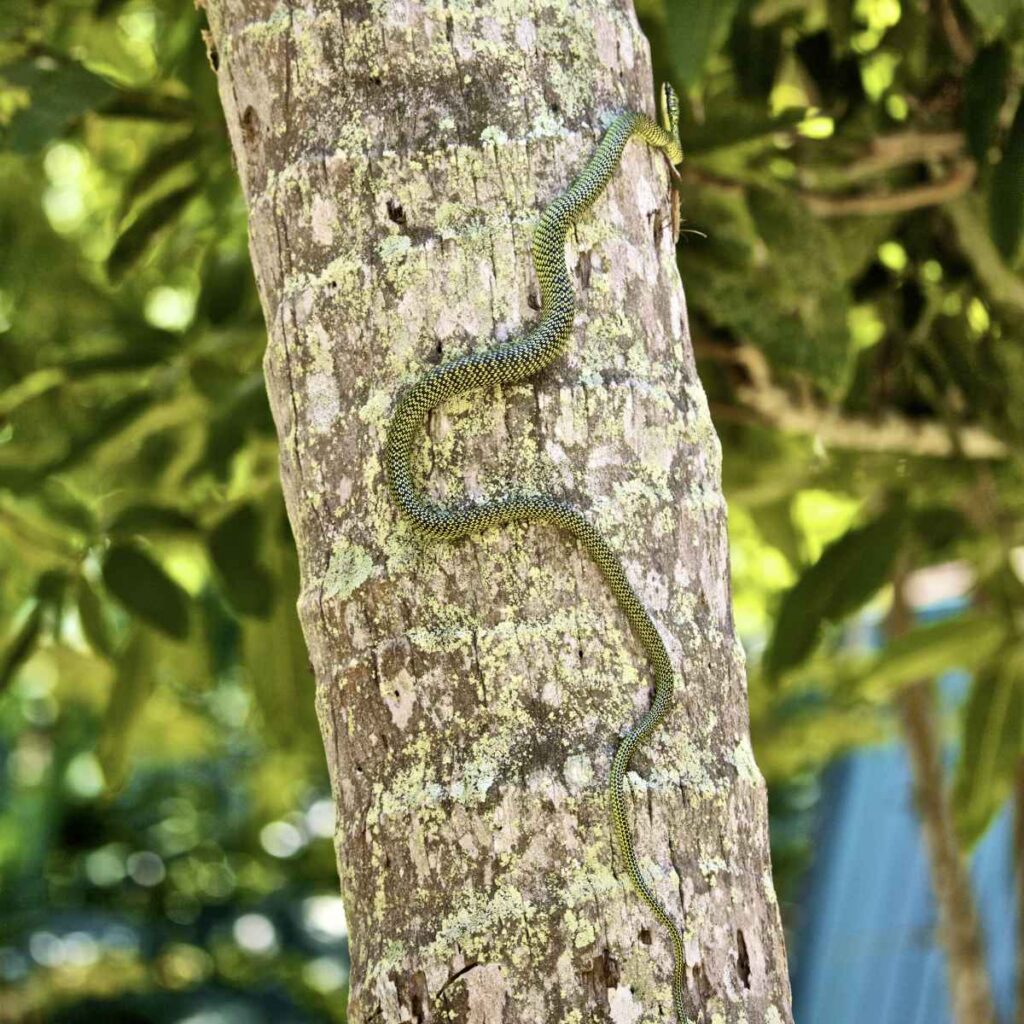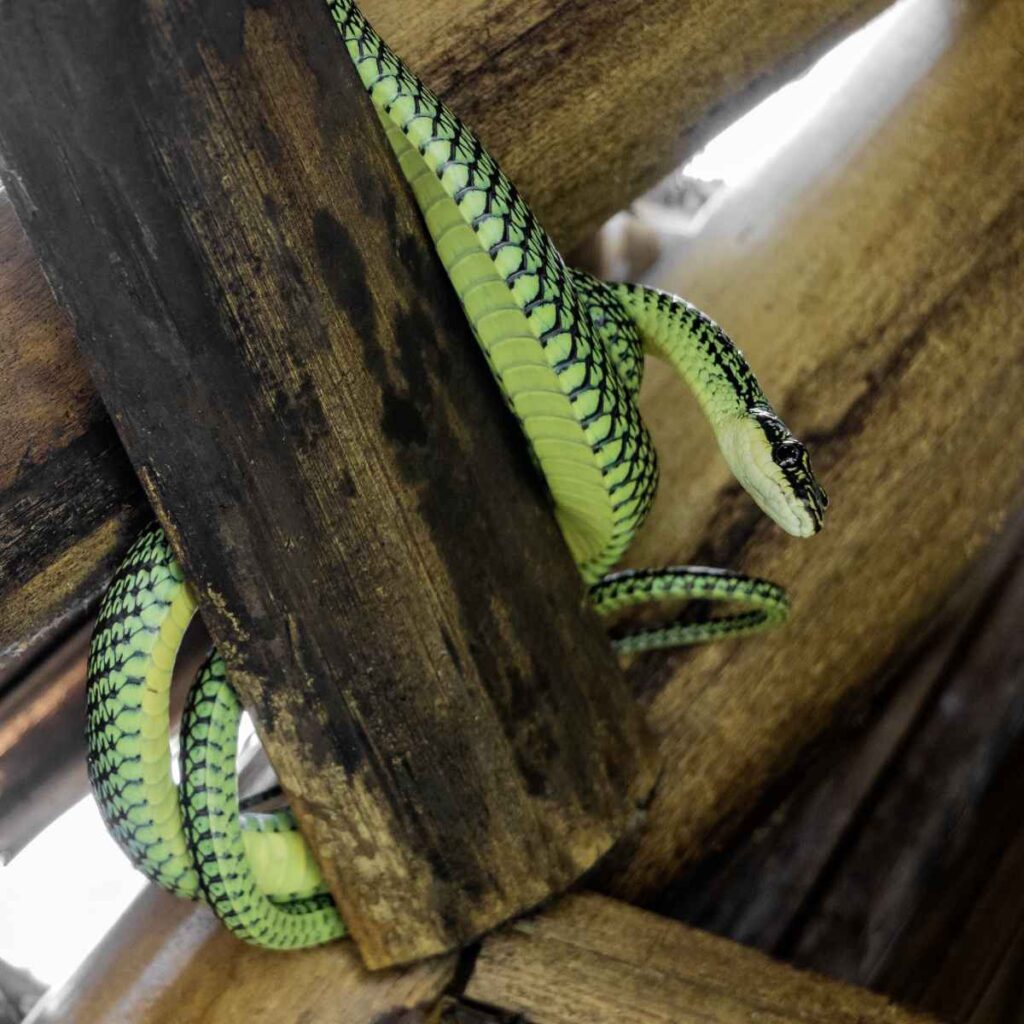Last Reviewed and Updated on March 7, 2023
They might sound like an animal straight out of a sci-fi movie, but flying snakes are very real. These incredible snakes are known for their unique ability to glide through the air, using their elongated bodies to soar from tree to tree. Explore these exciting facts about flying snakes as well as all the basic information about these snakes.

About Flying Snakes
Flying snakes, also known as gliding snakes, are a group of snakes that are known for their unique ability to glide through the air. They belong to the genus Chrysopelea and are found in mainland Southeast Asia, Indonesia, the Philippines, southernmost China, India, and Sri Lanka.
There are five known species of flying snakes:
- Golden tree snake or ornate flying snake
- Paradise tree snake
- Twin-barred tree snake or banded flying snake
- Moluccan flying snake
- Sri Lankan flying snake
While the behavior in the wild isn’t well studied in all species, flying snakes are mostly considered arboreal, meaning they spend most of their time in trees. They prefer forests and wooded areas, but they can also be found in gardens and other areas with trees.
These snakes look like any other snake, except when they are making a glide. They are small to medium-sized snakes, depending on the species, and come in various colors and patterns.
They feed primarily on lizards and small mammals, but they have also been known to eat birds and bats. Flying snakes are diurnal, which means they are active and hunt during the day.
Flying snakes are oviparous animals, meaning they lay their eggs.
The conservation status of most flying snakes is considered to be of “least concern” with stable populations.
Interesting Facts About Flying Snakes
Ready to get to know them even better? Read these facts about flying snakes.

Like unusual creatures? Also, check out the following;
1. They can’t actually fly; they glide
Although their name suggests they fly, they aren’t capable of true flying. The only animals that can fly are birds and bats. Flying snakes glide through the air, and when they do, they can make long glides. These snakes climb up trees, and when they reach the end of s branch, they continue moving until only their tail touches the end of the branch, and then they leap into the air.
Some other gliding animals include the colugo, flying squirrels, flying fish…
Fun fact: most flying snakes are capable of making better glides than most flying squirrels and some other gliding animals.
2. When gliding, they turn their body into a “pseudo concave wing”
When they leap into the air, they flare out their ribs and flatten their abdomen, making a pseudo wing, nearly doubling the width of their body. They also make a continual serpentine motion, just as other snakes do on the ground, which helps them stabilize their glide and adjust the direction in midair.
3. Some flying snakes can glide as far as 330 feet / 100 meters
They really are impressive gliders. Many flying snakes can glide as far as 330 feet / 100 meters, despite their lack of wings or limbs. They determine the landing spot when they launch in the air but are capable of some adjustment of altitude and direction in the air.
4. Smaller flying snakes generally glide better than larger ones
A study done in 2005 conducted by researchers at the University of Chicago confirmed that the size of the snake affects its ability to glide. Smaller snakes are more efficient in their glides and can glide longer distances than larger ones (source).
5. Flying snakes are mildly venomous
They do poses a venomous bite, but they aren’t dangerous to humans. Only a few medically relevant (not fatal) bites have been recorded. Their venom is only dangerous to small animals that they prey upon.
6. They are rear-fanged snakes
The primary difference between rear-fanged and front-fanged snakes, as the naming suggests, lies in the position of their venom-delivering fangs. Front-fanged snakes have long fangs located in the front of their upper jaw, and rear-fanged snakes have smaller, grooved teeth located towards the back of their upper jaw.
Front-fanged snakes, such as cobras, can inject larger volumes of venom fast and have a stronger bite force than rear-fanged snakes.
7. Golden tree snake is the largest flying snake
Out of the four species of flying snakes, the Golden tree snake (Chrysopelea ornata) can grow to be the longest. It can grow to about 4.27 ft / 130 cm in length.
Twin-barred tree snake (Chrysopelea pelias) is the smallest species of flying snake, with a maximum length of about 29.5 in / 75 cm.
8. Paradise tree snake is a very popular pet snake
The paradise tree snake (Chrysopelea paradisi) is the most popular pet snake among the four flying snakes. These snakes have black bodies covered with bright green scales along with clusters of red, orange, and yellow-colored scales that resemble the shape of flower petals on their back, from the base of the neck to the tail.
9. They “fly” to move from tree to tree
These snakes glide from tree to tree to move from one hunting ground to another or to escape predators. They do not catch their prey in midair.
10. Flying snakes are excellent climbers
Since their gliding requires them to climb up a tree, this fact probably doesn’t come as a surprise. Flying snakes can scale all kinds of trees and are great climbers.
